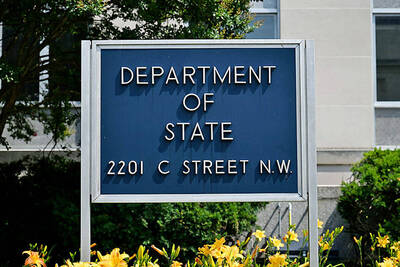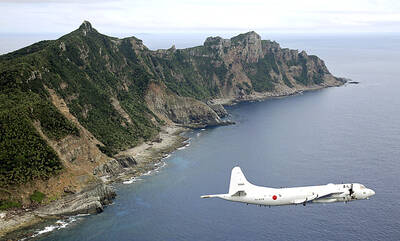Poor Chinese farmers facing forced resettlement for their nation’s latest vast hydro project bear a wrenching past, none more so than the survivors of an exodus to the high northwest from 1959.
The central canal for the South-to-North Water Transfer Project will take water from the Danjiangkou Dam, which first rose during former Chinese leader Mao Zedong’s (毛澤東) fervent and ultimately calamitous attempt from 1958 to rush the country into communist plenty.
“At that the time, the country was calling for young people to volunteer to go to Qinghai,” recalled Zhao Jingzhou, a white-whiskered farmer in his late 60s from Shizigang Village beside the dam. “Material life was pretty hard, but if you went to volunteer in Qinghai you could have a safer life.”
But Zhao and thousands of other villagers found that the promise of a more secure life in the arid highlands of the northwest province next to Tibet turned to disaster.
That experience, along with decades of poverty, now echoes in the farmers’ anger at the prospect of moving again for the water transfer scheme.
“We have eaten too much suffering already,” Zhao said, using a common Chinese saying.
The villagers have been ordered to resettle hundreds of kilometers away later this year.
Fifty years ago, drawn by promises of a better life thousands of kilometers from their homes in central Henan Province, over 22,000 of the dam-side farmers signed up to move to Qinghai.
The government was opening up the long-isolated region with the same utopian zeal that inspired Mao’s Great Leap Forward.
But the Great Leap Forward and the exodus of the dam migrants ended in deadly famine that older villagers in Shizigang recalled in matter-of-fact, sometimes bitter, tones.
“All there was to eat was paste,” Zhao said, describing a kind of nutritionless glue that famished farmers pounded from roots and wild plants. “A lot of people starved, especially the older ones who fell sick. There was no medicine for them.”
Historians believe that about 20 million, perhaps up to 30 million, Chinese people died from lack of food as Mao’s attempt to create massive communes and collective canteens collapsed in inefficiency, mismanagement and widespread brutality.
The old farmers of Shizigang also said that the reservoir, now the centerpiece of the water transfer project, was spared none of that suffering.
“There was no food to eat so I went to Qinghai. When we first went it was okay. Life was harder but we could manage,” said Shi Jinsheng, another dam migrant who volunteered to move to the northwest in 1959. “But then there was less food there and then none. Our bellies bloated like babies’.”
One local author, Mei Jie, quoted documents from the Qinghai famine in her 2007 history of the dam and the transfer project, The Great River Goes North.
“Owing to poor living adjustment, as well as the climate and poor acclimatization, not only is the spread of epidemics extremely serious, the death rate is about 30 percent,” stated one 1961 government report from Xichuan County, Henan, which sent the dam migrants to Qinghai.
That would mean about 7,000 died. Other documents in the book put the number at about 5,400.
Nearly all the survivors fled back to the dam area, either escaping, as Zhao did, or later moving back with the help of officials. Those still alive are now scattered around there, or the other towns and villages where they were later resettled.

MISINFORMATION: The generated content tends to adopt China’s official stance, such as ‘Taiwan is currently governed by the Chinese central government,’ the NSB said Five China-developed artificial intelligence (AI) language models exhibit cybersecurity risks and content biases, an inspection conducted by the National Security Bureau (NSB) showed. The five AI tools are: DeepSeek, Doubao (豆包), Yiyan (文心一言), Tongyi (通義千問) and Yuanbao (騰訊元寶), the bureau said, advising people to remain vigilant to protect personal data privacy and corporate business secrets. The NSB said it, in accordance with the National Intelligence Services Act (國家情報工作法), has reviewed international cybersecurity reports and intelligence, and coordinated with the Ministry of Justice Investigation Bureau and the National Police Agency’s Criminal Investigation Bureau to conduct an inspection of China-made AI language

BOOST IN CONFIDENCE: The sale sends a clear message of support for Taiwan and dispels rumors that US President Donald Trump ‘sold out’ the nation, an expert said The US government on Thursday announced a possible sale to Taiwan of fighter jet parts, which was estimated to cost about US$330 million, in a move that an expert said “sends a clear message of support for Taiwan” amid fears that Washington might be wavering in its attitude toward Taipei. It was the first announcement of an arms sale to Taiwan since US President Donald Trump returned to the White House earlier this year. The proposed package includes non-standard components, spare and repair parts, consumables and accessories, as well repair and return support for the F-16, C-130 and Indigenous Defense Fighter aircraft,

CHECKING BOUNDARIES: China wants to disrupt solidarity among democracies and test their red lines, but it is instead pushing nations to become more united, an expert said The US Department of State on Friday expressed deep concern over a Chinese public security agency’s investigation into Legislator Puma Shen (沈伯洋) for “secession.” “China’s actions threaten free speech and erode norms that have underpinned the cross-strait ‘status quo’ for decades,” a US Department of State spokesperson said. The Chongqing Municipal Public Security Bureau late last month listed Shen as “wanted” and launched an investigation into alleged “secession-related” criminal activities, including his founding of the Kuma Academy, a civil defense organization that prepares people for an invasion by China. The spokesperson said that the US was “deeply concerned” about the bureau investigating Shen

DISPUTE: A Chinese official prompted a formal protest from Tokyo by saying that ‘the dirty head that sticks itself out must be cut off,’ after Takaichi’s Taiwan remarks Four armed China Coast Guard vessels yesterday morning sailed through disputed waters controlled by Japan, amid a diplomatic spat following Japanese Prime Minister Sanae Takaichi’s comments on Taiwan. The four ships sailed around the Senkaku Islands — known as the Diaoyutai Islands (釣魚台) to Taiwan, and which Taiwan and China also claim — on Saturday before entering Japanese waters yesterday and left, the Japan Coast Guard said. The China Coast Guard said in a statement that it carried out a “rights enforcement patrol” through the waters and that it was a lawful operation. As of the end of last month,